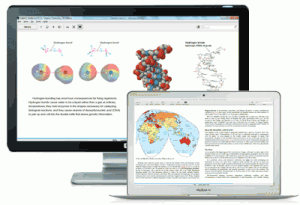 In the early days of the Kindle, especially after the initial release of the Kindle DX, it was pretty clear that Amazon had high hopes of it being the biggest piece of portable electronics to hit college campuses since the graphing calculator. Sadly, this didn’t work out quite how they had hoped. The Kindle, especially the original Kindle but to an extent even now, was simply unsuited for optimal use in even its most obvious settings.
In the early days of the Kindle, especially after the initial release of the Kindle DX, it was pretty clear that Amazon had high hopes of it being the biggest piece of portable electronics to hit college campuses since the graphing calculator. Sadly, this didn’t work out quite how they had hoped. The Kindle, especially the original Kindle but to an extent even now, was simply unsuited for optimal use in even its most obvious settings.
Of course a 7 inch black and white screen would work out poorly for displaying a chemistry textbook that uses full-color diagrams and often takes up approximately fifty square feet of desk space when opened, but when they couldn’t compete with cheap paperbacks in literature classes, it was time to consider backing off for a bit. The Agency Model of eBook pricing just drove that ideal moment even further away by removing the element of student savings from the equation.
Now, they’re going back to school and taking a new approach to things. Not an original approach, per se, but perhaps more effective than what came before. Even now, the Kindle is perhaps not best suited for the college text, but the fact that the word Kindle appears in the program name might be a bit misleading in this case. It is hard to see any indication that the Kindle eReader is meant to be an important part of the new program.
Electronic book lending is becoming a big thing on college campuses already. It makes a lot of sense compared to physical book rentals since the provider isn’t left with stacks of last year’s editions when the release cycle rolls out a new, marginally updated text. Companies like Chegg and CourseSmart have made names for themselves in this area, though Chegg still seems concentrated on the physical rental option. Renting saves students money, decreases production/transportation/storage overhead, and has the potential to become the next big thing on campuses. Of course Amazon would want to get in on this.
Now, you can rent a textbook (assuming the publisher has chosen to make it rentable) for anywhere from 30 to 180 days and save significantly over the purchase price. The selection isn’t strong yet, but it seems to be growing and the savings can be as much as 80%. Very few of these books will be worth picking up to read on your Kindle, however. All of the old objections to textbook reading on a small black and white screen still apply. That does not make this a silly move for Amazon so much as a possibly mislabeled effort.
When people think of the Kindle Store, they generally associate it with the Kindle. This makes sense. In the case of textbooks, however, the target audience is the Kindle App user. Be it on a PC, Mac, or iPad, a textbook is just going to be more useful on a larger color display. While I am personally seeing just about everything Amazon does lately as a move to get ready for the upcoming Kindle Tablet, and this would certainly help, even without that they have a solid customer base and freely available software that pretty much everybody knows about. If they can just find a way to point out to people that the value of the program is not connected to its integration with their Kindle, it could be a huge thing in months to come.